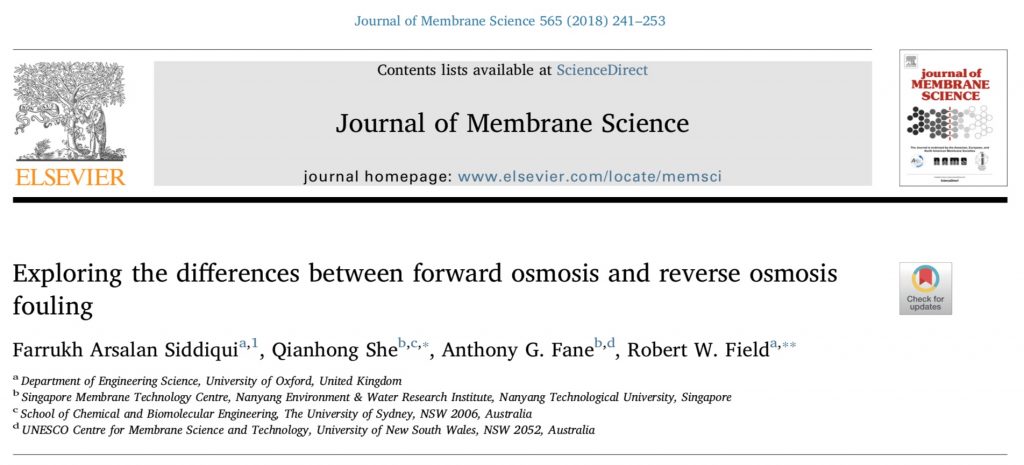- Nano-selective forward osmosis technology by SideStroem featured in Everything About Water - February 10, 2024
- SideStroem and Singapore Institute of Technology featured in AsianScientist - April 29, 2023
- SideStroem joins world class accelerator program - November 12, 2022
On August 23rd 2018, Siddiqui and co-workers – including renowned Anthony G. Fane, published the article “Exploring the differences between forward osmosis and reverse osmosis fouling” in Journal of Membrane Science.
The main take-home messages of their study go against the widespread perception that forward osmosis is a low-fouling technology due to the absence of hydraulic pressure in FO processes.
Double the amount of alginate fouling on FO membranes compared to RO membranes
In contrast to previous studies on FO vs RO fouling, where fouling propensity in many cases was evaluated solely on flux decline and where experimental conditions were not comparable between FO and RO experiments, the researchers in this study ensured following conditions were met:
- Same initial water flux
- Constant overall driving force for both FO and RO experiments
- Same membrane used for both FO and RO experiments
After a 16h parallel fouling test, the researchers – rather surprisingly – found that:
- The amount of deposited fouling agent (alginate) was 2.25mg/cm2 for FO and 1.24mg/cm2 for RO.
- The foulant resistance (Rf) was more than 5 times higher for FO than RO (both before and after cleaning of the membranes). This goes against the common notion that FO membranes are easier to clean.
- The specific foulant resistance (Rf/mf) was 3 times higher for FO vs RO indicating a much denser foulant layer on the FO membrane.
No evidence of hydraulic compaction effect leading to dense fouling layers in RO and loose fouling layers in FO
The researchers went one step further and designed a series of experiments to quantify the effect of hydraulic pressure on foulant layer compaction and found no evidence of such an effect.
Surprisingly, in all experiments, water flux increased after the compaction period indicating removal of foulant layer.
What are the underlying mechanisms?
In summary, Siddiqui and co-workers have concluded that foulant layer build-up and compaction is due to hydrodynamic drag forces (i.e the water flux across the membrane drives fouling) and not hydraulic pressure per se.
Ultimately, in FO processes, the ICP self-compensation effect – where a small decrease in water flux due to initial fouling results in a large decrease in ICP – increases the effective driving force leading to partial water flux compensation, which in turn leads to greater foulant accumulation. In fact, during the course of the 16h fouling test, the research team measured a 2-fold increase in the effective driving force for the FO processes and a slight decrease in driving force for the RO processes.
FO is fouling resilient but not low-fouling
So what are the immediate implications of these results for the FO field as a whole?
For starters, FO should no longer be referred to as a low-fouling technology when compared to RO. Additionally, the notion that FO foulant layers are more loosely attach and hence easier to remove in subsequent cleaning steps is also effectively debunked.
Due to the ICP self-compensation effect, however, FO water flux is more resilient to fouling and will decline at a much lower rate despite a higher degree of foulant deposition.
Is FO still a viable technology when compared to RO?
Our answer is yes. At the end of the day, water flux stability is a key advantage from an industrial operations point of view. And here FO excels over RO. This especially holds true for challenging high-fouling applications, which remain to be one of the “sweet spots” for FO.

